Sunnyside Yards & Affordable Housing: Real Estate Development
Published March 23, 2017 / Drafted May 18, 2015 / Long Island City / NYC History & Neighborhoods / Sunnyside Yards & NYC Railroad History / Gotham Buzz NYC.
This report is part of a series which you can find at - Real Estate Development of Affordable Housing in NYC: Sunnyside Yard.
As this report constitutes a deep dive into the various aspects of developing residential housing over Sunnyside Yards in Queens, I've provided the following Directory so you can click to view a section or scroll through the work in its entirety.
- Perpetual Tenants: The History of Government Funding of Publicly & Privately Owned Rentals
- Public Policy Goals: To Create Apt Rentals or Create Apt Owners
- Community Approach To Sunnyside Yards Development
I. Perpetual Tenants: The History of Government Funding of Publicly & Privately Owned Rentals
Public Investments / Private Ownership / Regulated Rents
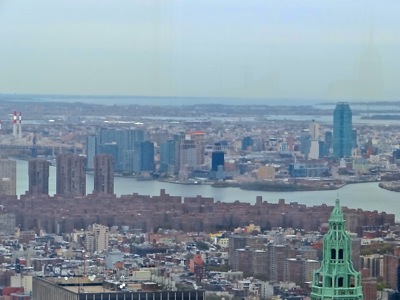 Past efforts to address New York City’s housing crises have only mitigated the problem temporarily, as evidenced by periodic flare ups.
Past efforts to address New York City’s housing crises have only mitigated the problem temporarily, as evidenced by periodic flare ups.
In the 1940’s Stuyvesant Town / Peter Cooper Village was one of the first public private partnerships designed to address what at the time was a temporary affordable housing shortage. The city helped demolish the housing in and around the old ash piles [CONFIRM] of the east side east of First Avenue and between 14th and 23rd Streets in order to erect a number of high rises in their place. Hence the erection of Stuyvesant Town / Peter Cooper Village.
My general understanding is that the government cleared the land and helped Met Life Company make the financials work through government tax abatements and financing. The company [MetLife] built the housing complexes and henceforth provided New York City residents with rent stabilized housing.
At the time [1940’s] some community activists were concerned that the development would create an overly dense population zone. As you can see from the photos showing much higher buildings around the Stuyvestant Town / Peter Cooper Village complex, that times have changed.
Government Builds & Rents Housing Complexes
 This public / private effort was both preceded and followed by government lead housing efforts made via the collaboration of various levels of government agencies to create affordable housing.
This public / private effort was both preceded and followed by government lead housing efforts made via the collaboration of various levels of government agencies to create affordable housing.
In Queens, the Queens Bridge Housing project, Ravenswood Housing project, Astoria Houses – to name but only a few in western Queens – arose during this period. These public housing projects are maintained by the government and rented to low and moderate income families.
The photo at right shows Queens Bridge Public Housing Project which is located north of Queens Bridge and adjacent to a Con Edison power plant.
GI Loans, Housing Ownership & The Growth of the Middle Class
During the 1940’s and 1950’s there was a ‘white flight’ as many of the Caucasians living in these projects were able to move out during America’s economic heyday. Following WWII the United States was about the only nation left standing with a very modern and totally functioning economy. Lower and middle income citizens were able to buy homes in the suburbs – as this was made possible by low interest GI loans - and it spurred the growth of what we’ve come to know as the American middle class.
Click here to continue reading the rest of our report about affordable housing in NYC & Sunnyside Yards real estate development.
Sunnyside Yards & Affordable Housing: Real Estate Development
Published March 23, 2017 / Drafted May 18, 2015 / Long Island City / NYC History & Neighborhoods / Sunnyside Yards & NYC Railroad History / Gotham Buzz NYC. Continued.
Koch Administration: Addresses Affordable Housing Crisis
In the mid 1980's Mayor Ed Koch announced a plan to address the then current affordable housing crisis. According to a book by Associate History Professor Jonathan Soffer, Koch's plan was the biggest initiative to address affordable housing since the 1920's. In the plan the Koch Administration sought to add 100,000 new housing units by the early 1990's by fixing and making available publicly owned buildings and space, through zoning changes and other government lead initiatives. The initiatives were oftentimes also funded in part by the government. Soffer wrote that the Koch Administration's effort to address affordable housing was one of its biggest achievements.
21st Century: Bloomberg Administration & Housing
 While the Koch Administration was successful in addressing the issue of affordable housing, affordable housing was one of the Bloomberg Administration's biggest failures.
While the Koch Administration was successful in addressing the issue of affordable housing, affordable housing was one of the Bloomberg Administration's biggest failures.
During the Bloomberg Administration period, homelessness grew from about 25,000 to between 50,000 and 60,000 – which is nearly [3/4] one percent of the entire NYC population. Even worse is that between a half and a third of these homeless people are school age children.
This sort of family and economic instability should not be ignored in any society as it will only breed long-term social and civic problems in the future. A stitch in time saves nine.
Bloomberg Administration: Housing That’s 'Affordable' To Whom?
The Bloomberg Administration initiated a number of ‘affordable housing’ initiatives. The government provided billionaire real estate developers and their real estate development companies with tax breaks, tax incentives, infrastructure investments and significant amounts of low interest government financing from municipal and state governments to build what they called 'affordable housing'.
In return these developers allocated a percentage of their units - a percentage that seemed to diminish with every round of government review - to affordable housing. The label of 'affordable housing' was based on income levels – and hence many folks who applied for it told me that it was a misleading label, as many of the units are completely 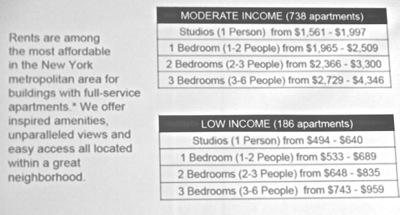 unaffordable to more than half of the residents of Queens and New York City.
unaffordable to more than half of the residents of Queens and New York City.
See Hunters Point South 'affordable housing chart' for its opening in Spring of 2015 at right.
Many of the units included in the Queens real estate developments sold to the public as affordable housing units, rented for as much as $50,000 per year, which is slightly less than the entire income of the median New Yorker [about $55,000 / year].
Given the median household income in New York is between $50,000 and $60,000 calling these rental units affordable seems deceitful at best.
Demand Will Continue To Grow: Real Estate Investment Trusts
As I understand it, three real estate investment trusts now focus primarily on the New York City market. As corporations have an indefinite life span [hypothetically in perpetuity], they can amortize investments over longer periods of time. Corporations also have easier access to capital through equity investments, partnerships and financing with which to make real estate investments work. This leaves the individual homeowner and families at a severe disadvantage when it comes to bidding for property ownership.
Consolidation of Property Ownership Through Capital Markets
Thus over the long haul, real estate ownership, just like in other businesses, will be increasingly consolidated over time by larger and larger entities. Left to its ultimate conclusion, most folks will become the equivalent of serfs on the land, making just enough in income to take care of their basic living needs - after paying the rent. By some accounts, this is already happening.
II. Public Policy Goals: To Create Apt Rentals or Create Apt Owners
A. Publicly Funded, Privately Owned Rental Units & Residual Values
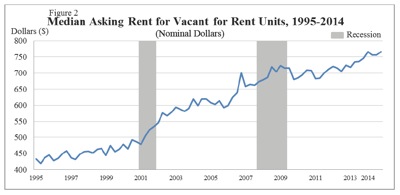 If someone rents the affordable housing units of Hunters Point South in LIC, that were priced at the high end of $4,300 per month or $51,600 in rent per year, for twenty years, that renter would have spent ONE MILLION DOLLARS on rent and have nothing to show for it. And this assumes the rent doesn’t go up.
If someone rents the affordable housing units of Hunters Point South in LIC, that were priced at the high end of $4,300 per month or $51,600 in rent per year, for twenty years, that renter would have spent ONE MILLION DOLLARS on rent and have nothing to show for it. And this assumes the rent doesn’t go up.
If one uses the twenty year chart for rents in the U.S. as a guide to future rental prices, rents not going up seems unlikely [see chart at right].
I use the high end rents of one of the 'affordable' housing projects funded and financed in part by the Bloomberg Administration to make a point.
But the point is a valid one for all affordable housing rentals. Renters end up with nothing - no residual value - after spending between a third to a half of their income on housing every month of every year. So the solution to subsidize their rent, doesn't address the long term, bids up rents in the market and is a temporary band-aid at best.
Home Ownership is the Largest Component of American Wealth
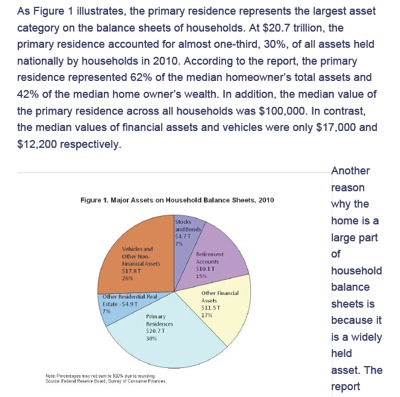 Subsidizing corporations and wealthy individuals with land giveaways, tax abatements & giveaways and low interest public loans to build affordable housing rentals is actually a poverty-perpetuating policy.
Subsidizing corporations and wealthy individuals with land giveaways, tax abatements & giveaways and low interest public loans to build affordable housing rentals is actually a poverty-perpetuating policy.
It doesn't address the root cause which is to help the lower and middle classes escape their economic plight. In fact is exacerbates the national wealth disparities, because the government is subsidizing and financing the investments in housing made by the rich, which will be paid for in totality by their less well off renters.
Public policy makers must give more consideration to enabling the ownership of publicly sponsored housing projects, rather than solely to the task of trying to create more housing.
See chart on wealth and home ownership to your right. A third of national wealth is in housing, but the pie / picture is distorted by the other assets owned by the wealthy.
For the median income citizen, housing ownership represents about two thirds of their wealth.
Do Rentals Really Constitute Affordable Housing?
People who are perpetual renters are trapped in a rut of systemic poverty as between a third and a half of their after-tax income evaporates monthly with no long term equity. Those who are able buy and own their own home build wealth and become upwardly mobile into the middle and upper classes.
This begs the question, will building more price controlled rental units ever really solve the affordable housing shortage? It seems the real solution - the long term solution - to addressing chronic affordable housing shortages is to create home ownership, not just build more rental housing units.
Let's continue our journey by delving into the economic challenges of creating a new class of homeowners. And we will start by taking a look at the history of U.S. government efforts to promote home ownership.
B. American Government History Of Promoting Home Ownership
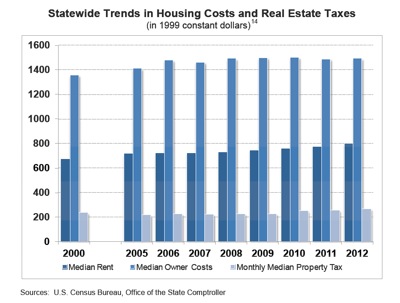 Two 20th century New Deal government programs contributed greatly to the growth of the American middle class.
Two 20th century New Deal government programs contributed greatly to the growth of the American middle class.
The first was providing loans to GI's returning from WWII so that the could divert the 25% to 30% of their income that they would spend on rent, into loan payments on the purchase of their homes. This enabled them to build equity through home ownership and create wealth.
There was a similar bill passed by the federal government around the same time that provided financial assistance which enabled returning GI’s to obtain a college education, which made them eligible for more highly skilled and thus better paying jobs.
Given the significant portion of wages New Yorkers allocate to rent [25% to 50%], government policy makers must simultaneously attempt to address home ownership, along with the building of new residential units, if they are really going to address the long term affordable housing shortage in New York City.
The dual public policy strategy would produce a dual public policy benefit because by enabling tenants to gain ownership of their primary residence, they would also begin to address the growing disparity of the allocation of wealth in this country. This is a topic that has already come to the fore as we are in the early stages of the upcoming 2016 presidential election.
Lincoln & the Homestead Act: Creating Wealth, Citizen Stakeholders & a Healthy Middle Class
If we go back even further in time, to a century and a half ago, we see another precedent by the U.S. government to incent its citizenry to "take stock in America" by owning their own land. The Homestead Act of 1862 enabled citizens to own 160 acres of land if they filed a claim for the plot with a government registrar, and then worked the land for at least five years. After the five years they became the rightful owners.
Home Ownership Rates NYC Versus USA
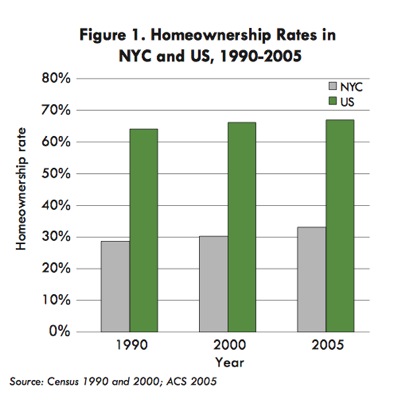 In New York City, less than 30% of residents are homeowners; whereas in the nation as a whole about 65% of the residents are homeowners [see chart].
In New York City, less than 30% of residents are homeowners; whereas in the nation as a whole about 65% of the residents are homeowners [see chart].
Generally homeownership in cities is lower than in the nation as a whole. Boston, one of the closest major metro areas to NYC has a home ownership rate in the mid 30’s, while a city like Houston has a home ownership rate between 50% and 60%.
By building rental housing, regardless of whether it is publicly or privately owned by the few, the government appears to be perpetuating New York City's recurring affordable housing crises by funding the construction and concentrated ownership of rental units in the city.
During the Bloomberg years we heard reports that some investors bought rent controlled housing units and then closed them down in hopes of 're-inventing' the property in order to skirt rent controls in search of market rates. There are myriad of legal issues associated with this strategy, but large wealthy investors can afford teams of skillful lawyers.
The state programs, which provide rental subsidies to individuals, are also short term band aids that do not appear to have solved the problem, but rather may be making it worse by increasing the funds available for the demand side of the housing equation, which further drives up rates on rental units.
Based on what we were able to learn, it appears that government spending on housing would be better spent on funding the creation of housing units and enabling the acquisition of them by their tenants. Then do a sort of price stabilization of the housing unit, so that the price of said unit goes up at a controlled rate and the owner can sell it for any amount up to that price to another person who will occupy that residence as their primary home and agree to the same pricing controls on the resale price of the home. In this manner each new unit of affordable housing built, remains an affordable housing unit.
This is just an idea and there are plenty of details that would have to be worked out, but it would begin to correct the skew to subsidizing the wealthy ownership of housing units to enabling the citizenry to own their housing units.
21st Century Homestead Act: Enable Tenants to Acquire Equity
The modern equivalent of Lincoln’s Homestead Act might be to do something along the lines of enabling home ownership by requiring the new tenant / owners to meet certain conditions of homeownership, in a manner similar to being approved for a home loan and / or meeting the requirements of a long term tenant. A bit like the Homestead Act, require them to occupy the unit as their primary residence [and owning no other property] for a minimum length of time before they can resell at a price stabilized [like rent stabilized] rate.
The financial folks could configure the financial cash flow streams such that some measure of the monthly rent would be allocated toward equity to enable ultimate home ownership of the unit by the approved tenant over a number of years. This would be the equivalent of giving tax breaks to the citizenry of Queens & NYC, in a manner comparable to the multi-year tax abatements given to multi-billionaire real estate developers by prior administrations.
Creating Wealth From Air & the Economics of Tenant Home Ownership
Going back to Wilbur J. Wilgus’ statement referenced in the prior report – the government can create wealth from the air by building up. As mentioned previously at a recent real estate conference one of the developers told me that the incremental cost of adding another floor is a very, very modest expense that carries with it a very high incremental return on investment.
The Economics Of Making Queens Home Ownership Possible
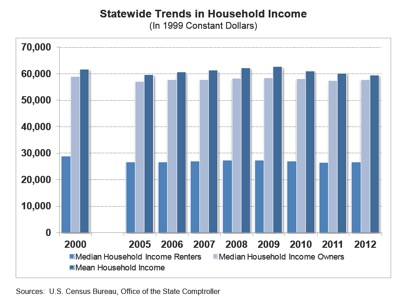 City and State governments are in a position to begin to break the recurring affordable housing cycle by doing something equivalent to Lincoln’s Homestead Act and enable folks to buy the property based on a certain set of conditions.
City and State governments are in a position to begin to break the recurring affordable housing cycle by doing something equivalent to Lincoln’s Homestead Act and enable folks to buy the property based on a certain set of conditions.
Let's examine the economics starting with the chart at right showing the incomes of home owners versus renters. Renters tend to be younger and have lower income and oftentimes don't have a lot of assets with which to make a downpayment on a home.
The government has a number of variables with which to work in creating truly affordable housing and making the economics work. Perhaps the biggest variable is in how high it builds up and which affects the number of units it creates to rent / sell. The higher a building rises, the lower the average cost per unit. The lower the cost per unit, the lower the initial investments and ongoing payments required to support ownership.
Financial Calculations of Creating a New Class of Home Owners
Rough Draft Example. Home owners get tax breaks, as all of the interest on the home loan is tax deductible.
So if you make $55,000 per year [roughly median income] and you buy a unit for $350,000 which is 100% financed at a 4% interest rate on a 30 year fixed loan the payments are about $1657 per month. And let's say the purchase price included the payment of a separate $50,000 loan to the government in lieu of the down payment.
Let's assume you pay taxes of 17% federal, 7% state and 3% city, so rounding up - let's say about a 30% tax rate.
In the first year of the mortgage, nearly all of the mortgage payments are going toward interest, which is tax deductible - which means you get about a third of your monthly payment - or about $500 per month back.
So if the government 'sold' that apartment to you which you agreed to live in for the next five or ten years to obtain home ownership [like the Homestead Act] for a payment of say $2,000 per month, wherein the $500 per month would go toward your equity in the down payment, and the rest would go toward the loan.
Adjusted for taxes, $1500 x 12 = $18,000 / $55,000 income = 33% of income. Of course there is insurance, taxes and building maintenance and repairs too, but you begin to see that these numbers can be made to work enabling the median income Queens resident to possibly buy a home.
Applicants would be making a net payment of about $1,500, because of the tax deduction for interest. A $1,500 per month payment is the same as the low end of the Hunters Point South 'affordable' housing rents, but these applicants would have the considerable added benefit of owning their unit over time, plus the tax breaks that now go to the developers, while the Hunters Point South tenants would end up with nothing in residual value after spending a third to a half of their income on rent.
Going forward, instead of 'stabilizing' the rent of the unit, the sales price would be 'stabilized' by using a calculated formula that pegs the price to median income, so that the unit is always affordable to the average New Yorker who enrolled in a random lottery to be eligible to buy the unit. Thus the tenant / owner would benefit from some market appreciation of their residence, compared to today, where they receive no residuals from the rent they pay.
What's the Difference: Tax Abatements for Billionaires or for Citizens?
Thus zoning can be used to create affordable housing units to be sold to the general public via a Homestead-like Act. City, state and federal government officials can work with private lenders - like Queens neighborhood banks - to put together the prospective tenant / owner financing.
This financing effort would be comparable to the provision of low interest loans made by both city and state governments to the multi-billion dollar real estate development firms over the past decade, with the primary difference being that the loans would be made to residents meeting certain New York citizenry and financial requirements.
Neighborhoods Win: Resident Ownership, Wealth Accumulation & Disposable Income
The added benefits to neighborhood would manifest itself in having community stakeholders who would, over time, have incremental wealth and disposable income by virtue of the equity benefits of home ownership. The disposable income would flow into community businesses like neighborhood banks and small businesses, local realtors, local construction industries, professional services, local stores, restaurants, schools, libraries, local culture and the arts.
Neighborhoods are the big winners when people own their own homes. They have a vested stake in the community, and through equity growth in their home, they have growing financial power which manifests itself in higher disposable income which goes back into neighborhood.
Be advised that this is all hypothetical. It's the sketch of ideas, some of which the merits should be given some consideration vis a vis other proposals. It seems a more equitable approach to distributing housing / property ownership than we've seen to date.
III. Community Approach To Sunnyside Yards Development
Infrastructure, Population Density, Affordable Housing, Home Ownership & Piecemeal Development
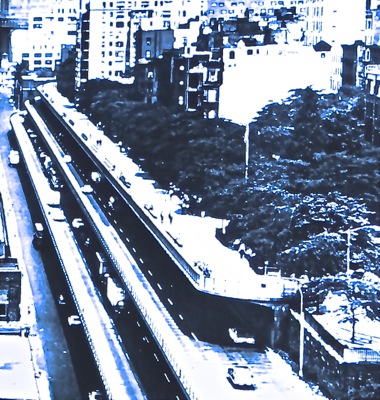 We will address infrastructure in our next report in this series as it merits a thorough examination on its own.
We will address infrastructure in our next report in this series as it merits a thorough examination on its own.
What follows is a discussion about some of the issues for the surrounding neighborhoods and communities to consider as they become engaged in the development process surrounding the potential development of Sunnyside Yards.
Development Opposition Successes: Historical Preservation & Parkland
In the 1940's Brooklyn Heights convinced Robert Moses to build the Brookly Queens Expressway [BQE] around the community after a hard fought battle over other matters, many of which were conceded by the community. The BQE underneath the Brooklyn Heights promenade is shown at right.
In the 1960's Moses also sought to build a parking lot near Tavern on the Green in Central Park, but the mothers of the Upper West Side banded together and blocked this attempt and succeeded in getting a playground instead.
The 1968 Penn Central proposal to build above Grand Central Terminal was defeated. The defeat was again due to historical preservation, and the very high profile support from former First Lady Jacqueline Kennedy Onassis. The interior of the Beaux Arts Grand Central Terminal is shown below right.
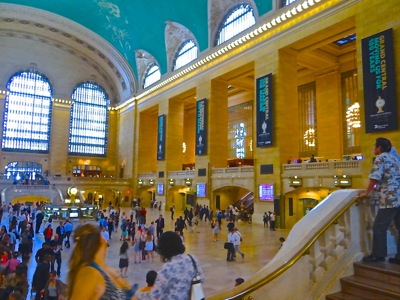 There was a 21st century proposal to build a soccer stadium in Flushing Meadows Corona Park. The soccer stadium never came to fruition because there were a large number of federal, state and municipal environmental, open space and park issues that could have kept the project in limbo indefinitely.
There was a 21st century proposal to build a soccer stadium in Flushing Meadows Corona Park. The soccer stadium never came to fruition because there were a large number of federal, state and municipal environmental, open space and park issues that could have kept the project in limbo indefinitely.
Community Opposition Failures: Density & Design
In the 1940’s Stuyvesant Town / Peter Cooper Village was initially opposed because residents said that the population density would be too great. By today’s standards in Manhattan it’s not a particularly densely populated area. In fact the Upper East Side holds that title.
In the 21st century there was a Midtown East development that the community opposed only a couple of years ago, that the then Borough President Scott Stringer voiced opposition to - just before he signed off on it. In the end that real estate development plan didn’t become a reality, but for other reasons.
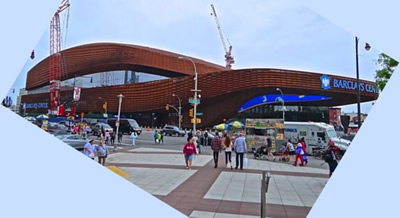 Perhaps the best analogy to the proposal for Sunnyside Yards is the Atlantic Yards development in Brooklyn. The community opposed the development, championed by Mayor Bloomberg, to build atop the Atlantic rail yards.
Perhaps the best analogy to the proposal for Sunnyside Yards is the Atlantic Yards development in Brooklyn. The community opposed the development, championed by Mayor Bloomberg, to build atop the Atlantic rail yards.
In the end, the proposal went through, and in an eleventh hour attempt the community came up with an alternate design. But it was far too little and far too late. The ship had sailed and the activists in the community got nothing, perhaps, depending on what you think of the appearance of Barclays Center, they might have gotten an eyesore. Barclays Center is shown in the photo at right.
Sunnyside Yards: Community Response Alternatives
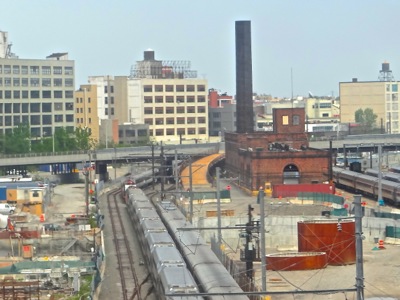 If the community is going to oppose the development of affordable housing on the largest open space in New York City, located only two miles away from Grand Central Station [some of the priciest real estate in New York City] during an affordable housing crisis - it needs to have a good reason. The space isn’t parkland and at present it’s not an historic site. And based on what I have been able to gather about the environmental issues, they do not at this point appear to be anything out of the ordinary - but I could be wrong about this as there is a Superfund clean up going on in nearby Newtown Creek.
If the community is going to oppose the development of affordable housing on the largest open space in New York City, located only two miles away from Grand Central Station [some of the priciest real estate in New York City] during an affordable housing crisis - it needs to have a good reason. The space isn’t parkland and at present it’s not an historic site. And based on what I have been able to gather about the environmental issues, they do not at this point appear to be anything out of the ordinary - but I could be wrong about this as there is a Superfund clean up going on in nearby Newtown Creek.
There is a little station house in Sunnyside Yards. I understand that it used to be some sort of fire plan and has a lot of asbestos, which is why the railroad company hasn't moved or demolished it.
Population density in and of itself, as you can see from some of the community oppositions above, has not worked. There is no doubt that Long Island City, Sunnyside, Astoria and for that matter Queens – is in need of some additional investments in infrastructure such as schools, transit and open space to keep pace with the borough and neighborhood population growth.
But infrastructure for western Queens is another full length subject and one I intend to tackle in the next installment of this series on the Sunnyside Yards but at a far later date.
Infrastructure As An Issue - Next Report In This Series
The ability of Queens infrastructure to support a significant new development in western Queens is possibly the most cogent opposition issue. But like all significant issues and challenges - there are solutions. It just depends on the time frame and the amount of money one wants to invest.
So in the fifth report in this series, I will explore the public policy issues associated with developing the additional infrastructure required in Western Queens such as schools, libraries, transit, space for neighborhood businesses, as well as to environmental issues and the current affordable housing crisis.
Thanks for reading this and participating in our democratic processes by informing yourself. An informed electorate is a necessity for a democratic government to function effectively.
Click here to learn more about Queens real estate and development and click here to view a section we dedicated to the issues surrounding the real estate development of Sunnyside Yards NYC.
Gotham Buzz Subscriptions
We work very hard to help keep you informed by providing you with independent news coverage, as well as information about events in the arts, culture and business in the borough. 
You can help us continue to provide you with independent, first-person, fact-based, contextural reporting by purchasing an annual voluntary subscription, which we've priced to accommodate all budgets.
Thanks for your encouragement and support.
Sunnyside Neighborhood Links
Click on these advertisements for promotions, discounts and coupons by retailers and restaurateurs in Astoria and nearby Queens.
Click this link to go to the Sunnyside & Woodside Neighborhood.
LIC Neighborhood - Long Island City Links
Click on these advertisements for promotions, discounts and coupons by retailers and restaurateurs in Long Island City LIC and nearby Queens. Click here for a related story about the hotels & restaurants in Dutch Kills section of Queens.
Click this link to go to the Long Island City Neighborhood.
Site Search Tips. 1) For best results, when typing in more than one word, use quotation marks - eg "Astoria Park". 2) Also try either singular or plural words when searching for a specific item such as "gym" or "gyms".
$element(bwcore,insert_search,N)$
Click the log in link below to create an ID and post an opinion.
Or send this story to a friend by filling in the appropriate box below.










